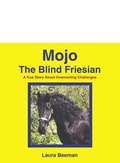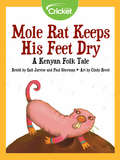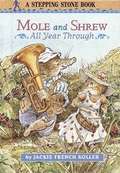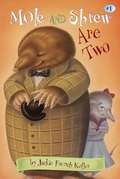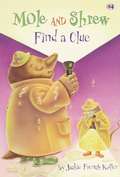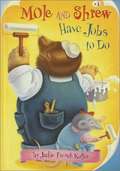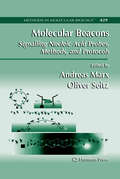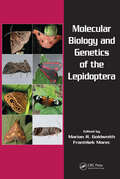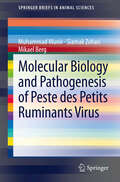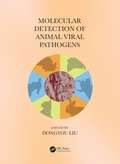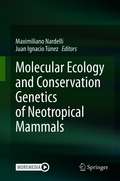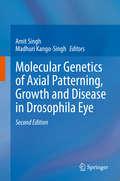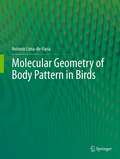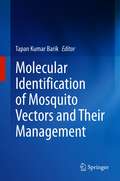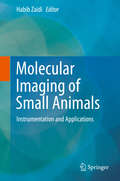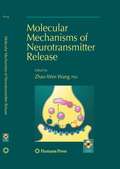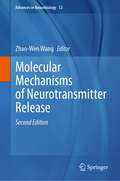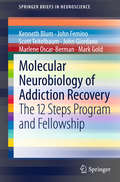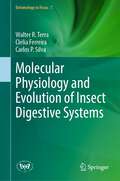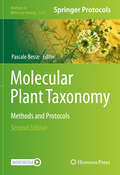- Table View
- List View
Mojo The Blind Friesian
by Laura BeemanThis is the true story of Mojo a blind friesian horse who overcame many obsticles to become a member of a quadrille. He used his other senses to move around his environment.
Molang Loves (Molang)
by Jenne Simon<P> Molang loves lots of things... like dressing up in silly costumes and watching movies and taking pictures and, of course, going to parties! Today Molang and Piu Piu are going to a party at a friend's house, but Piu Piu is having a bad feather day! Looks like it's up to Molang to cheer Piu Piu up. Because if there's one thing Molang loves more than anything, it's Piu Piu. <P>Don't miss this beautiful storybook!
Molded 4 Murder (Sophie Kimball Mystery #5)
by J.C. EatonA view to a kiln … Sophie “Phee” Kimball enjoys working as a bookkeeper for a private investigator. If only her mother Harriet could enjoy her retirement at Sun City West in Arizona—instead of constantly getting involved with retirees being prematurely put out to pasture. This time Quentin Dussler, a prominent member of the clay sculpting club, was found dead, clutching a piece of paper scrawled with Phee’s mother’s name. Terrified she’s been targeted by assassins, Harriet begs Phee to investigate. What Phee uncovers is a complicated scheme that only the most diabolical of murderers would ever devise. And as she chisels away at confusing clues and potential suspects, Phee unearths something far more precious and valuable than she could imagine. Eager for answers, she takes a bold step—placing herself in the crosshairs of a stonefaced killer … Praise for the Sophie Kimball Mysteries “A witty adventure that will leave you laughing out loud.”—Stephanie Blackmoore, author of the Wedding Planner Mystery Series, on Booked 4 Murder “Fun characters, a touch of humor, and a great mystery, the perfect combination for a cozy.”—Lena Gregory, author of the Bay Island Psychic Mysteries, on Ditched 4 Murder
Mole Is Not Alone
by Maya TatsukawaIn this cozy picture book about friendship, Mole anxiously decides to journey through underground tunnels to attend a party.Mole is invited to a party, which is very worrisome. What if the party is too rowdy for Mole? What if Mole doesn’t know anyone there? What if Mole is just too shy to make friends? Mole worries through the tunnels, around Snake’s burrow, under the forest, past Bear’s den, and all the way to Rabbit’s door. But despite all those worries, maybe Mole can find a quiet way to make friends . . . With warm and sweet illustrations, every page of Mole Is Not Alone is an invitation to look and look again. Readers can follow Mole’s tunnel as it connects from one page to the next, learning along the way that everyone can make friends, even if some parties are quieter than others.An Indie Next List Pick A Kirkus Review Best Book of 2023A Book Page Best Book of 2023
Mole Rat Keeps His Feet Dry: A Kenyan Folk Tale
by Gail JarrowElephant, Giraffe, and Lion urge Mole Rat to escape the rain with them, but Mole Rat assures them that he will stay dry underground.
Mole and Shrew All Year Through
by Jackie French KollerMole and Shrew celebrate a holiday for each season of the year and an extra one for New Year's. Whether Mole is worried about what a resolution is or hunting for the perfect "fur" tree, there is plenty of joy and hilarious confusion in this charming chapter book reissue.
Mole and Shrew Are Two
by Jackie French KollerFor fans of the Frog and Toad books and Amelia Bedelia stories, the antic tales of Mole and Shrew will prove to be worthy successors. In the introductory title, find out how Mole and Shrew first meet, how Mole finds a new home, and how, with much confusion along the way, Mole and Shrew finally become fast friends!
Mole and Shrew Find a Clue
by Jackie French KollerOne day, while Mole is out shopping, he overhears Buzzard telling someone that she is going to have Rabbit and his family for dinner. Could this be true? Could Buzzard be plotting to eat the whole Rabbit clan? It's up to Mole and his brave friend Shrew to get to the bottom of the situation. . . .
Mole and Shrew Have Jobs to Do
by Jackie French KollerIn this third title about Mole and Shrew, the fabulous friends find themselves a little short of cash. At Shrew's suggestion, the two head into the working world with hysterical results. Mole manages to thwart their attempts at everything from hanging wallpaper ("Where are the hooks?" asks Mole) to waiting on tables ("Why would you want to wait on a table? A chair would be more comfortable. ").
Mole and Shrew Step Out
by Jackie French KollerMole commits a comic blunder regarding a fancy ball, but his good friend Shrew sticks by him.
Molecular Beacons: Signalling Nucleic Acid Probes, Methods, and Protocols
by Oliver Seitz Andreas MarxFrom probe design to applications in clinical settings, this book provides a diverse set of instructive examples, guided by experts in the field who offer easy-to-follow experimentals. The book first offers an introduction to the basic principles of fluorescence and then describes applications of fluorogenic probes in real-time PCR, which currently is the gold standard for quantitative DNA and RNA analysis. Coverage extends the potential of realtime as well as advocates simplifications of the probe technologies. It also presents a new simplified molecular beacon design, EasyBeacons, and demonstrates the utility in DNA methylation profiling.
Molecular Biology and Genetics of the Lepidoptera (Contemporary Topics in Entomology)
by Marian R. Goldsmith František MarecNumerous and charismatic, the Lepidoptera is one of the most widely studied groups of invertebrates. Advances in molecular tools and genomic techniques have reduced the need for large sizes and mass-rearing, and lepidopteran model systems are increasingly used to illuminate broad-based experimental questions as well as those peculiar to butterflies. Putting the spotlight on the second most numerous order of insects living today, this book provides a summary of cutting-edge studies of the Lepidoptera as an organism in and of itself and as model systems. Leading researchers discuss symbiosis, genomes, sex determination, natural products, ecophysiology, sensory systems, pest control, the sterile insect technique, immunity, and evolution development. Understanding the biology and genetics of butterflies and moths may lead to new species-selective methods of control, saving billions of dollars in pesticide use and protecting environmental and human health, making the sections on pest control and the sterile insect technique extremely important.
Molecular Biology and Pathogenesis of Peste des Petits Ruminants Virus
by Muhammad Munir Siamak Zohari Mikael BergPeste de Petits Ruminants (PPR) is a highly contagious viral disease of domestic and wild small ruminants that can significantly affect economies. The authors are experts in the field and provide an up-to-date and comprehensive review covering all aspects of the disease. The book is divided into seven chapters highlighting genome organization, virus replication and the determinants of virulence, pathophysiology and clinical disease, immunology and immunopathogenesis, epidemiology, diagnostic assays and vaccines, and the challenges concerning global eradication. It is an invaluable reference work, presenting the latest information for virologists, microbiologists, immunologists, veterinarians, and scientists working in PPR research.
Molecular Detection of Animal Viral Pathogens
by Dongyou LiuMolecular Detection of Animal Viral Pathogens presents expert summaries on state-of-the-art diagnostic approaches for major animal viral pathogens, with a particular emphasis on identification and differentiation at the molecular level. Written by specialists in related research areas, each chapter provides a concise overview of an individual virus
Molecular Ecology and Conservation Genetics of Neotropical Mammals
by Maximiliano Nardelli Juan Ignacio TúnezAlthough all living beings modify their environment, human beings have acquired the ability to do so on a superlative space-time scale. As a result of industrialization and the use of new technologies, the anthropogenic impact has been increasing in the last centuries, causing reductions in the sizes or the extinction of numerous wild populations. In this sense, from the field of conservation genetics, various efforts have been made in recent decades to provide new knowledge that contributes to the conservation of populations, species, and habitats. In this book, we summarize the concrete contributions of researchers to the conservation of the Neotropical mammals using Molecular Ecology techniques.The book is divided into three major sections. The first section provides an up-to-date review of the conservation status of Neotropical mammals, the applications of the molecular markers in its conservation, and the use of non-invasive and forensic genetic techniques. The second and third sections present, respectively, a series of case studies in various species or taxonomic groups of Neotropical mammals.
Molecular Genetics of Axial Patterning, Growth and Disease in Drosophila Eye
by Amit Singh Madhuri Kango-SinghDrosophila melanogaster (fruit fly) is a highly versatile model with a genetic legacy of more than a century. It provides powerful genetic, cellular, biochemical and molecular biology tools to address many questions extending from basic biology to human diseases. One of the most important questions in biology is how a multi-cellular organism develops from a single-celled embryo. The discovery of the genes responsible for pattern formation has helped refine this question and has led to other questions, such as the role of various genetic and cell biological pathways in regulating the process of pattern formation and growth during organogenesis. The Drosophila eye model has been extensively used to study molecular genetic mechanisms involved in patterning and growth. Since the genetic machinery involved in the Drosophila eye is similar to humans, it has been used to model human diseases and homology to eyes in other taxa. This updated second edition covers current progress in the study of molecular genetic mechanisms of pattern formation, mutations in axial patterning, genetic regulation of growth, and more using the Drosophila eye as a model.
Molecular Geometry of Body Pattern in Birds
by Antonio Lima-de-FariaAfter having read this book you will never see birds in the same way again. The unexpected patterns displayed by a bird's body have been seen as bizarre events that demanded little attention or were described as 'amazing curiosities'. None of these surprising features seem to be fortuitous. They appear to be an integral part of a rigid order and a coherent geometry, which is directed by simple gene interactions and molecular cascades occurring at various cellular levels, and at different times, during the organism's development. A novel geometry unfolds in front of your eyes, giving the body configurations another meaning. Lima-de-Faria is Professor Emeritus of Molecular Cytogenetics at Lund University, Lund, Sweden. This is his sixth book dealing with the molecular organization of the chromosome and its implications for the understanding of the mechanisms responsible for biological evolution.
Molecular Identification of Mosquito Vectors and Their Management
by Tapan Kumar BarikThis book summarizes the recent advancements in identifying the mosquito vectors and discusses various strategies for their control. The book describes various molecular taxonomic methods, including DNA barcoding and single nucleotide polymorphism-based machine learning approach, which are used for the identification of mosquito vectors. It also presents the various mosquito control methods, namely, phytochemicals, Bacillus thuringiensis toxins, nanotechnology, biological control agents, and environmental management strategies. It also highlights the importance of various repellents that are used for protection from different kinds of mosquito vectors. Finally, the book offers a comprehensive yet representative description of challenges associated with mosquito vector-borne diseases. The book is a useful resource for medical entomologists, health workers, and researchers working in mosquito-control and vector-borne diseases.
Molecular Imaging of Small Animals
by Habib ZaidiThis book examines the fundamental concepts of multimodality small-animal molecular imaging technologies and their numerous applications in biomedical research. Driven primarily by the widespread availability of various small-animal models of human diseases replicating accurately biological and biochemical processes in vivo, this is a relatively new yet rapidly expanding field that has excellent potential to become a powerful tool in biomedical research and drug development. In addition to being a powerful clinical tool, a number of imaging modalities including but not limited to CT, MRI, SPECT and PET are also used in small laboratory animal research to visualize and track certain molecular processes associated with diseases such as cancer, heart disease and neurological disorders in living small animal models of disease. In vivo small-animal imaging is playing a pivotal role in the scientific research paradigm enabling to understand human molecular biology and pathophysiology using, for instance, genetically engineered mice with spontaneous diseases that closely mimic human diseases.
Molecular Mechanisms of Neurotransmitter Release
by Zhao-Wen WangWithin the complex neuronal network of the nervous system, neuron-to-neuron communication occurs mainly through chemical synapses, where the presynaptic nerve terminal releases neurotransmitters which control the function of postsynaptic neurons by acting on postsynaptic receptors. Recent decades have brought ground-breaking new developments and a wealth of knowledge to this field. In 'Molecular Mechanisms of Neurotransmitter Release', leading experts provide concise, up-to-date information on all major molecular mechanisms involved, with complete background information and figures and diagrams to further elucidate key concepts or experiments. Comprehensive and cutting-edge, 'Molecular Mechanisms of Neurotransmitter Release' is sure to provide a learning tool for neuroscience students, a solid reference for neuroscientists, and a source of knowledge for all those who have a general interest in the ever-evolving field of neuroscience
Molecular Mechanisms of Neurotransmitter Release (Advances in Neurobiology #33)
by Zhao-Wen WangNeurons communicate with each other by releasing neurotransmitters. This book provides comprehensive coverage of the molecular mechanisms involved in neurotransmitter release. The topics covered in the book range from the architecture and cytomatrix proteins of presynaptic sites, to the modes of synaptic vesicle exocytosis (full-collapse and kiss-and-run), and from the key molecules mediating synaptic vesicle fusion (SNAREs) to those that closely interact with them (UNC-13/Munc13, UNC-18/Munc18, tomosyn, and complexins). The book also delves into the calcium sensors of synaptic vesicle fusion (synaptotagmins and Doc2s), the sources of calcium that trigger synaptic exocytosis (voltage-gated calcium channels and ryanodine receptors), and the regulation of neurotransmitter release by potassium channels, cell adhesion molecules, lipids, aryl hydrocarbon receptor-interacting protein (AIP), presenilins, and calstabins. To aid in understanding and illustrate key concepts, the book includes sufficient background information and a wealth of illustrations and diagrams. The new edition includes major updates to previous chapters, as well as several new chapters that reflect the recent advances in the field. Comprehensive and cutting-edge, Molecular Mechanisms of Neurotransmitter Release, 2nd edition, is a valuable learning resource for neuroscience students and a solid reference for neuroscientists.
Molecular Neurobiology of Addiction Recovery
by Kenneth Blum Marlene Oscar-Berman John Femino John Giordano Mark Gold Scott TeitelbaumHumans are biologically programmed to seek out pleasurable experiences. These experiences are processed in the mesolimbic system, also referred to as the "reward center" of the brain, where a number of chemical messengers work in concert to provide a net release of dopamine in the Nucleus Accumbens. In some genetically predisposed individuals, addiction occurs when the mechanisms of the mesolimbic system are disrupted by the use of various drugs of abuse. Since Alcoholics Anonymous was founded in 1935, it's 12 step program of spiritual and character development has helped countless alcoholics and drug addicts curb their self-destructive behaviors. However, the program was developed at a time when comparatively little was known about the function of the brain and it has never been studied scientifically. This is the first book to take a systematic look at the molecular neurobiology associated with each of the 12 steps and to review the significant body of addiction research literature that is pertinent to the program.
Molecular Physiology and Evolution of Insect Digestive Systems (Entomology in Focus #7)
by Walter R. Terra Clelia Ferreira Carlos P. SilvaThis book provides a unique blend of data on insect life spans, physiology, enzymology and other molecular features associated with digestion and nutrient absorption to enrich the knowledge on insects and to disclose putative molecular targets for the development of new insect control technologies and for improving insect raising procedures to be used as food and feed. With this aim, the book overviews the types of diets consumed by insects, describing their chemical components demanding digestion and discusses the evolutionary selective pressures on insects associated with feeding. Digestive enzymes are classified and detailed according to their activity on substrates and their evolutionary protein families. The technical details on how to obtain reliable enzymological parameters are discussed. The book reviews the structural changes in enzymes associated with the adaptation of insects to new diets and in avoiding natural plant inhibitors. Midgut features that enhance digestive and nutrient absorption efficiency and their underlying molecular mechanisms are described regarding insects pertaining to key points in evolution. Evolutionary trends of the mechanisms of digestion and nutrient absorption are discussed.
Molecular Plant Taxonomy: Methods and Protocols (Methods in Molecular Biology #2222)
by Pascale BesseThis fully updated edition explores conceptual as well as technical guidelines for plant taxonomists and geneticists, such as the increasing use of next-generation sequencing (NGS) technologies for numerous applications in plant taxonomy. The volume provides molecular approaches to be used within an “integrative taxonomy” framework, combining a range of nucleic acid and cytogenetic data together with other crucial information (taxonomy, morphology, anatomy, ecology, reproductive biology, biogeography, paleobotany, etc.), which will help not only to best circumvent species delimitation but also to resolve the evolutionary processes in play. Written for the highly successful Methods in Molecular Biology series, chapters include introductions to their respective topics, lists of the necessary materials and reagents, step-by-step, readily reproducible laboratory protocols, and tips on troubleshooting and avoiding known pitfalls. Authoritative and up-to-date, Molecular Plant Taxonomy: Methods and Protocols, Second Edition is an ideal guide for researchers seeking a better understanding of evolutionary processes, at species and population level, through molecular techniques.
Molecular Toxicology in Caenorhabditis elegans
by Dayong WangThis book will focus on the molecular basis of oxidative stress induced by toxicants or stresses and various molecular signalling pathways in regulating the toxicity of toxicants or stresses in Caenorhabditis elegans. It will also cover the discussion on the aspects of response signals, G-protein coupled receptors and ion channels, specific molecular signals, and epigenetic signals involved in the regulation of toxicity from toxicants or stresses. The molecular basis for adaptive response for transgenerational toxicity of environmental toxicants or stresses will be further discussed. Nematode Caenorhabditis elegans is a classic model animal with well-described genetic and developmental backgrounds based on the study of life science, and has been further successfully and widely used in both toxicity assessment and toxicological study of various environmental toxicants or stresses. Based on related available data, this book aims at providing a systematic understanding of the knowledge system of molecular toxicology in C. elegans.
